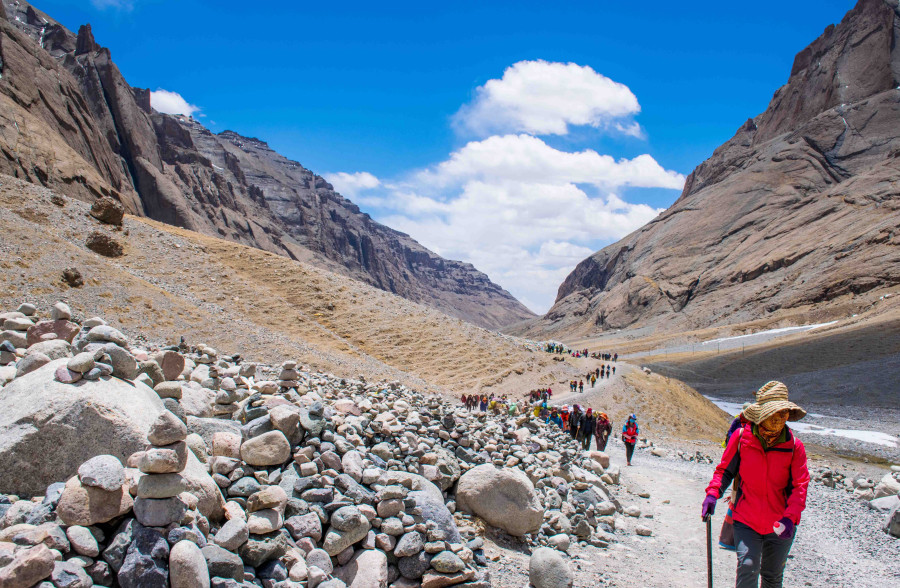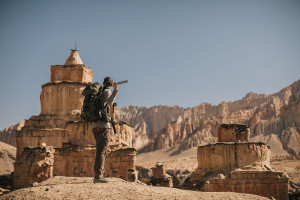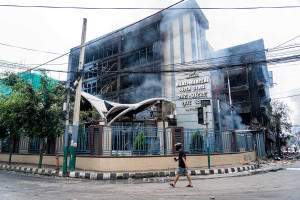Money
Pilgrims to Kailash discouraged by new Chinese rules
Nepali tour operators say the complex rules are designed to control the entry of foreign pilgrims, particularly Indians.
Sangam Prasain
Beijing has reopened several points on the Nepal-China border after three years, but also slapped so many restrictions making travel difficult.
Elation among pilgrims wishing to go on the holy Kailash Manasarovar tour has turned to despair because the stringent rules seem to be basically meant to keep visitors away, say insiders.
“When we saw the long list of rules, it was filled with hassles for both Indians and Nepalis,” said Basu Adhikari, managing director of Touch Kailash Travel and Treks.
Nepali tour operators say the complex regulations are designed to control the entry of foreign pilgrims, particularly Indians, for Kailash Manasarovar Yatra, one of the most sacred journeys for devotees.
Three prominent travel and tour operators—Nepal Association of Tour and Travel Agents, Trekking Agencies Association of Nepal and Association of Kailash Tour Operators Nepal—have submitted a memorandum to Chinese Ambassador to Nepal Chen Song urging him to help simplify the movement of pilgrims.
“The charges fixed by China for Indians are higher than those for tourists from third countries,” says the memorandum, a copy of which has been obtained by the Post.
Kailash Manasarovar Yatra is one of the lucrative tour packages for Nepali tour operators.
The annual pilgrimage season would be a boom time for the tourism industry, and the government too would see increased revenue from taxes. The religious travellers would fill the hotels and restaurants, and keep travel agents, airlines, guides and porters busy.
“The Kerung border point has been opened recently. China is also opening the border at Hilsa,” said Adhikari. “That’s welcome. But the rules introduced by China are too stringent.”
The re-opening of the northern border has cheered the tourism industry at a time when the country is wallowing in a recession. Nepal has been putting its hopes on tourism to revive the moribund economy.
But pilgrims wanting to visit the world’s fastest-growing major economy have to face many hassles. Indian pilgrims have to make a trip to New Delhi to get their visa for Tibet.
“The pilgrims must be present physically to get the visa. There is no online application system,” said one unnamed travel agent.
Nepali tour operators say that biometric details are now compulsory to obtain a visa. Earlier, Chinese authorities used to collect the biometric details at the immigration office at the border points.
As per the new rules, Indian pilgrims should be in a group of at least five people to obtain visas, and at least four of them should be present physically.
Tour operators say they can’t figure out the wisdom behind these new rules which they say are impractical.
For Nepali operators, who were hoping that their northern neighbour’s softening policy would help their businesses to recover, there are numerous hassles.
China has increased the “grass damage charge” for Nepali workers entering Tibet to $300 per person from $100.
Nepali workers go to Tibet as guides, porters or kitchen staff assisting the pilgrims.
“As per the new rules, biometric details are also mandatory for Nepali workers and they should obtain them from the visa facilitation services (VSF) centre at Rising Mall,” said Adhikari. “Earlier, biometric details used to be taken at the immigration offices at the border.”
Another hassle for Nepali firms operating tours to Kailash Manasarovar is that they have to deposit $60,000 or Rs8 million each to send pilgrims to Tibet, as per the rule imposed by the Foreign Exchange Centre of Tibet.
As per Nepali laws, Nepali travel agencies are not permitted to deposit funds in foreign banks.
“We have informed the Chinese Embassy in Nepal, the Embassy of Nepal in Beijing and the Consulate General of Nepal in Lhasa about this matter,” said Adhikari.
Chinese authorities have also increased the visa fee for Nepali workers from Rs4,200 to Rs13,000 for a 15-day stay.
“While Nepal has waived visa charges for Chinese entering Nepal, China’s new policy has surprised all of us,” said another travel agent who sends Indian pilgrims to Tibet.
From January 1, 2016, in a bid to boost arrivals from the north, the Nepal government decided to waive the visa fee for Chinese visitors—a facility enjoyed only by visitors from South Asian countries till then.
Prices for a 14-day Kailash Manasarovar Yatra package by surface route start at IRs185,000 per person.
Travellers flying from Nepalgunj to Simikot and onward to Hilsa and then journeying overland to Kailash Manasarovar pay IRs225,000 each.
A tour package involving flying from Kathmandu to Lhasa costs IRs320,000 for Indians and $4,000 for other tourists.
The Kathmandu-Lhasa service, the only international gateway to Lhasa, has not resumed.
Nepali tour operators say they have been inundated with bookings from Indian pilgrims as the destination has been reopened after three years.
“But we are in a total dilemma due to the new rules which will discourage Indian pilgrims from going on the holy journey,” said Adhikari.
The number of Nepali pilgrims too has started increasing. According to Adhikari, nearly 400 Nepalis have booked the Kailash Manasarovar Yatra for Janai Purnima, which is observed in the month of Shrawan.
Travel trade entrepreneurs say that Indian arrivals to Nepal have soared, mainly for religious purposes. In April, Nepal received 31,400 Indian tourists, up from 25,900 in March.
According to travel traders, more than 20,000 Indian pilgrims travelled to the sacred mountain and lake in China via Nepal in 2018.
In 2019, the number rose sharply to nearly 30,000. Then Covid-19 came as a spoiler, and China closed the border in January 2020.
The holy travel season begins in April and lasts until October. Mid-June to early September is monsoon season in Tibet, but it is the peak season and the most expensive period to travel there.
There are five routes to Mt Kailash and Lake Manasarovar.
One is the disputed Lipulekh Pass. India has been opening the track of the link road for Manasarovar Yatra from Dharchula to Lipulekh, known as the Kailash-Manasarovar Yatra Route.
Nathula in Sikkim, India is another. However, these routes are the longest and most expensive. It takes nearly three weeks to reach the holy place using these routes, and the trip is difficult too.
Moreover, only a few pilgrims travel on these routes as they need to get a special permit from the Indian government.
Nepal offers three routes to Kailash Manasarovar through the Tatopani and Rasuwagadhi border points. After the Chinese government closed these border points, Nepalgunj became the key gateway.
The Nepalgunj-Simikot-Hilsa-Manasarovar route is the shortest, and the itinerary is affordable and easy. Travellers usually fly from Nepalgunj to Simikot by fixed-wing aircraft, and then take a helicopter to Hilsa on the border with Tibet, China.
As Nepalgunj has become a major gateway, more than a dozen luxury hotels have sprung up here to cater to Indian visitors.
After crossing Karnali, pilgrims are taken by motor vehicle to China.
Due to the high altitude, pilgrims acclimatise for one to two days in Purang, also known as Taklakot, the first city in Tibet. Lake Manasarovar lies at an elevation of 4,556 metres.




 16.12°C Kathmandu
16.12°C Kathmandu













%20(1).jpg&w=300&height=200)
